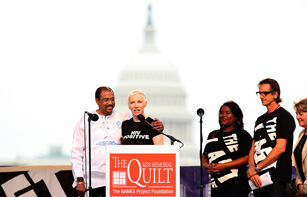
L to R: UNAIDS Executive Director Michel Sidibé, UNAIDS Goodwill Ambassador Annie Lennox, Trina Scott from Advocates for Youth, Patrick Holzfaster from Levi Strauss & Co. and Julie Rhoad, Executive Director of the NAMES Project. Washington DC, 21 July 2012. Credit: UNAIDS/C.Kleponis
As thousands of delegates from around the world gather for the XIX International AIDS Conference in Washington, the NAMES Project AIDS Memorial Quilt, one of the most prominent symbols of the global response, was unveiled across the metropolitan DC area.
UNAIDS Executive Director Michel Sidibé and UNAIDS Goodwill Ambassador Annie Lennox joined the NAMES Project Foundation, several high-level personalities and around 300 members of the YouthForce activist alliance at the unveiling ceremony at the Mall. After a section of the Quilt was unfolded, those gathered took turns to read the long list of names.
Part of the Quilt, which is now well over 30 years old, will be displayed in 50 venues from 21-25 July, including at the National Mall. The entire Quilt, the largest community art project in the world, carries the names of 94 000 people who have lost their lives to AIDS on more than 48 000 individual panels. During the ceremony, a single panel from 1988 that has yet to be sewn into the quilt was displayed publicly for the first time. The design of the panel simply says “The last one”.
The memorial, which is now 50 miles long, affords an opportunity to look back at the previous decades of the AIDS epidemic and to reflect on what needs to be done in future to ensure that no further names are added, that each new name should be the last one.
“It is possible to imagine a day when we will sew the last panel in the AIDS Quilt,” said Mr Sidibé. “Until that day comes, we must do everything we can to work towards an AIDS-free generation. We have a clear goal, so let us make it happen.”
Throughout its history, which began in 1987 when activists in San Francisco found a resonant way to remember friends and loved ones lost, the Quilt has been used to challenge prejudice and raise both awareness and funding. So far it has led to US$ 4 million in donations for services for people living with HIV. It is also been used as a means to join hands across the global community in the AIDS response and as an effective tool in HIV education and prevention. Based in the United States, the Quilt now has an international profile with panels from nearly 30 other countries.
According to Annie Lennox, the human toll of the epidemic and the real cost of inaction are starkly and powerfully presented in an arresting visual way.
“For thirty years, global AIDS activists and campaigners have been working to create the effective and lasting changes we need to see before we reach the stage of zero new HIV infections,” said Ms Lennox. “We are now at a crucial point in history when could actually see the dream become a reality in our lifetime. It is therefore, absolutely imperative that we see this thing through. We can, and we must,” she added.
It is possible to image a day when we will sew the last panel in the AIDS Quilt. Until that day comes, we must do everything we can to work towards an AIDS-free generation. We have a clear goal, so let us make it happen
UNAIDS Executive Director Michel Sidibé
There was an emphasis on youth at the ceremony; given the critical role young people have to play in the AIDS response now and in the future. They bear a heavy burden, with 2 400 new HIV infections among 15-24 year olds occurring every day: they account for 40% of all adults who are newly diagnosed as HIV-positive. The gathering heard how young people need to lead the challenge to the epidemic and that they hold the power to turn the tide in their hands.
The ceremony, though sombre, was also full of hope that in remembering those who have been lost, the AIDS community is further galvanized and reinvigorated in its effort to bring about the vision of zero new HIV infections; zero discrimination and zero AIDS-related deaths.




